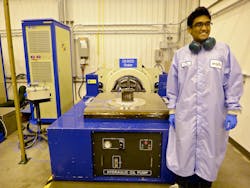An ongoing NASA initiative aims to help students discover the excitement of space exploration while confronting related technology and engineering challenges. As part of this program, dubbed CubeSat, 11 small research satellites were recently launched. One was developed by a group of high-school students. Since its inception in 2010, the CubeSat Initiative has selected more than 90 cubesats from primarily educational and government institutions around the U.S.
This file type includes high resolution graphics and schematics when applicable.
Confirmations that the satellites are operating as planned have already been received. As the teams begin to receive signals from the cubesats, which are in low-earth orbit, they will be tasked with confirming activation and other normal operations of the nanosatellites. The cube-shaped satellites measure about 4 in. on each side, have a volume of about 1 qt., and weigh less than 3 lbs.
NASA’s Educational Launch of Nanosatellite (ELaNa) missions, which are conducted under the CubeSat initiative, give students, teachers, and faculty hands-on experience developing flight hardware. In the process, they gain access to a low-cost avenue for research. Cubesats from nine universities, a NASA center, and a high school were launched. The TJ3 Sat from Thomas Jefferson High School for Science and Technology in Alexandra, Virginia—the first high school to participate in the program—contains a voice synthesizer module that will take written phrases in the form of code and produce a phonetic voice reading on the satellite’s downlink frequencies.
Also among this group of launches was PhoneSat 2.4, a second-generation smartphone cubesat sponsored by NASA’s Space Technology Mission Directorate. This mission will test the smartphone’s viability as a communications technology for nanosatellites while verifying that its hardware can manage pointing, taking images, and executing software appropriately. It has been upgraded from the previous PhoneSat mission to include a two-way radio, which enables command of the satellite from the ground. In addition, solar arrays enable operation for up to a year. A system for attitude control also has been included.
Notably, the fourth ELaNa mission marks the first flight of the Nanosatellite Launch Adapter System (NLAS), a satellite deployment system built by Ames. NLAS is capable of carrying approximately 100 lbs. of secondary payloads into orbit. It also can accommodate various configurations of cubesats. Groups can participate in the program by submitting a proposal to NASA for what they want to accomplish with their cubesat. More information about the initiative can be found here.
About the Author
Iliza Sokol
Associate Digital Editor
Iliza joined the Penton Media group in 2013 after graduating from the Fashion Institute of Technology with a BS in Advertising and Marketing Communications. Prior to joining the staff, she worked at NYLON Magazine and a ghostwriting firm based in New York.


